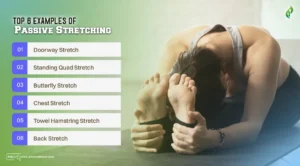Last Updated on November 19, 2024 by Helena Akter
Feeling tight and inflexible lately? No matter how much you stretch, your muscles never seem to loosen up. In fact, your risk of injury increases with tight muscles. In these cases, passive stretching can relieve tight muscles, restore range of motion, and prevent stiffness. Now, you might ask how to do passive stretching.
To do passive stretching, position yourself comfortably and use an external force like a partner or gravity to stretch the muscle. This method improves flexibility without exerting effort from the muscle being stretched.
Today, you’ll learn not only passive stretching but also positions for all major muscle groups. Plus, we’ll share the benefits and some rules, so you’ll be able to loosen up tight muscles and move more freely.
What is Passive Stretching?
Passive stretching is a method where you hold a stretch for 30 seconds to two minutes, similar to static stretching. However, the key difference is that you use outside help, like a —
- Towel
- Resistance band
- Gravity
- Or even another person
to assist in the stretch. It helps take some of the effort off you, unlike in static stretching where you maintain the stretch on your own.
But if you’re trying a passive form of stretching for the first time, be cautious. It’s easy to stretch too far and injure yourself due to the power of stretching. So, always pay attention to how your body feels during a stretch; it shouldn’t be painful.
Many people think they are more flexible than they actually are, leading to overstretching. For safety and effectiveness, consult a professional, such as a licensed physical therapist or massage therapist.
What Are the Most Important Rules When Stretching?

The American College of Sports Medicine recommends stretching two to three times a week. Here are eight important guidelines for stretching:
Warm Up Before Stretching
Many people stretch to warm up, but it’s also common to stretch after exercising. Starting with a warm-up helps raise your body temperature and makes muscles more flexible, which can lead to a better workout.
You can warm up with activities like —
- Trying dynamic stretches
- Doing jumping jacks or burpees
- Going for a light walk
Pay Attention to How You Stretch
It’s important to stretch correctly to avoid hurting your muscles or ligaments. And each stretch should be done in a specific way for the best results. Though there are online tutorials that can help, it’d be best to consult with a professional, known as a stretchologist.
And it’s ideal, especially if you’re unsure about the correct techniques to use.
Begin slowly and With care
To help your muscles relax and improve blood flow, stretch in a slow and gentle manner. Plus, avoid quick, jerky movements or bouncing, which can tighten your muscles and cause injuries.
Instead, start with smooth, gradual movements, focusing on the muscles you’re stretching.
Stretch All Major Muscle Groups
Certain sports and activities can cause some muscles to work harder than others, leading to uneven muscle use. To maintain balance, it’s important to stretch all the major muscle groups.
Experts suggest stretching these groups and their opposing muscles two to three times a week, though daily practice is also beneficial.
Stop If It hurts
Feeling some resistance and slight discomfort is normal when you stretch, but if it starts to hurt, that’s your cue to stop. Stretching should make you feel good, not cause sharp or intense pain. Drink some water or try a fizzy juice that can help you lose weight as well as quench your thirst.
That said, aim for a gentle stretch that causes mild tension without pain. If it’s painful, take a moment to adjust your position or warm up a bit more before trying again.
Don’t Stretch Serious Injuries
While stretching can be beneficial, it might worsen certain conditions, such as a slipped disk or spinal stenosis. Injured muscles or joints need rest, and stretching them could delay healing or increase the injury.
Thus, if you have an injury, it’s best not to stretch unless a healthcare professional, like a therapist, has advised you to do so. Speaking of healthcare, you should get an affordable health insurance plan to minimize any out-of-pocket costs.
Breathe Slowly While Stretching
Many people forget to breathe during exercise or stretching. However, experts like stretchologists and fitness therapists emphasize the importance of breathing slowly and steadily.
Holding your breath can make your muscles tense and stretching more difficult. Try using yoga breathing techniques or any method that feels natural to you.
Choose a Reputable Stretch Studio
If you’re stretching for health reasons or as part of your workout, consider visiting a professional stretch studio. Even though you don’t need equipment to stretch and can do it anywhere, working with an experienced stretchologist can be especially helpful.
They can guide you through stretches tailored to your needs.
How to Do Passive Stretching?
Passive stretching comes in different forms. Here’s a simple guide to doing a hamstring stretch passively —
- Start by lying on your back, legs straight and relaxed.
- Lift one leg towards the ceiling, keeping it straight.
- Place a towel or strap behind your calf, thigh, or under your foot’s arch, wherever it feels best.
- Gently pull on the towel or strap, bringing your leg closer until you feel a stretch.
- Hold this position for up to 30 seconds.
- Repeat with the other leg.
Benefits of Passive Stretching
Passive stretching improves flexibility, movement range, and mobility, enhancing performance and reducing injury risks. It’s particularly helpful for those who can’t stretch independently. Here’s a breakdown —
- Improves flexibility and mobility
- Reduces the risk of injuries
- Supports those unable to stretch on their own
Research highlights its potential for muscle growth and combating muscle weakness. A 2013 animal study revealed that daily short stretches could help in muscle development.
Although more studies are needed to understand its full impact, initial results are promising, especially for individuals who are unconscious or suffer from paralysis.
A 2018 study on animals showed that regular stretching increases blood flow to muscles, potentially improving their function. This method, sometimes involving a splint, could benefit the elderly or those who can’t exercise on their own. Yet, detailed research on humans is essential to further these insights.

Why Does Stretching Feel So Good?
Stretching is more than a warm-up or cooldown for your workout; it’s a key to better health and happiness. Here’s a simple look at why stretching feels so amazing.
Improved Circulation
When you stretch, you’re not just loosening up your muscles; you’re also boosting blood flow. This increase in circulation brings more oxygen and nutrients to your muscles, helping to wake you up and ease muscle repair and soreness.
Relaxation Activation
Stretching does wonders for your relaxation. It turns on the part of your nervous system that calms the body down, leaving you feeling serene and lowering your stress levels.
Release of Endorphins
Did you know stretching can make you feel happier? It releases endorphins, the body’s natural feel-good chemicals, giving you a natural high and easing pain, much like the joy you feel after a good run.
Easing Muscle Tension
If you’ve been sitting or standing too long, stretching is a great way to tell your body to chill out. It eases muscle tightness and tension, making you more flexible and less prone to injuries.
Flexibility Boost
Adding stretching to your daily routine can make you more flexible. This means everyday tasks get easier, and you’re less likely to strain a muscle or get injured.
Stress Buster
The calming effect of stretching, thanks to those endorphins and the activation of the relaxation part of your nervous system, can greatly cut down your stress. It’s a perfect addition to any mental wellness plan.
Overall, stretching regularly, whether with a simple routine or using a stretch machine, can significantly improve your physical and mental well-being. Along with mental health, it’d be best to keep your heart fit as well by eating heart healthy foods.
How to Do Passive Standing Squad Stretching?
This stretch targets the quadriceps, the muscles at the front of your thighs —
- Stand beside something stable, like a wall or table, to keep your balance.
- Wrap a rolled towel or exercise strap around your right ankle.
- Grab the other end of the towel or strap with your right hand.
- Use your left hand for support by placing it on the table or wall.
- Gently bend your right knee, drawing your right foot towards your buttocks with the help of the towel or strap.
- Maintain this position for up to 30 seconds.
- Switch legs and repeat the process.
Top 6 Examples of Passive Stretches

A passive stretch can work a variety of muscles. So, here are some passive stretching examples you can try to get started —
[Note for Designer: Please create an Infographic]
1. Doorway Stretch
- Stand in a doorway.
- Put one foot slightly in front of the other to keep your balance.
- Lift your arms out to the sides. Bend your elbows like you’re holding a ball. Turn your palms forward.
- Press your forearms, elbows, and hands against the doorframe.
- Lean forward slowly, still holding onto the doorframe.
- Hold this position for 10 seconds.
- Rest for 5 seconds. Do it again.
2. Standing Quad Stretch
- Stand near something steady, like a wall or table, to help you balance.
- Roll up a towel or use a stretchy band.
- Put it around your right ankle.
- Hold the band or towel with your right hand.
- Put your left hand on the wall or table to keep steady.
- Slowly bend your right knee and pull your foot up towards your bottom using the towel or band.
- Hold for up to 30 seconds.
- Do the same on the other leg.
3. Butterfly Stretch
- Lie on your back with your arms resting by your sides.
- Place the bottoms of each foot together and slightly separate your knees.
- As your partner holds your knees, slowly push them towards the floor.
- Push back against their hands for five seconds, then let go for five seconds.
- Do this five times in total.
4. Chest Stretch
- Sit up straight with your legs stretched out in front of you.
- Your partner needs to kneel on one leg and use the other leg to support your back.
- Lift your arms so they are level with your shoulders.
- Your partner should then hold your elbows and slowly pull them backward.
- You should feel a stretch in your chest, arms, and upper back.
- Stay like this for up to 30 seconds.
- Then rest and do it five more times.
5. Towel Hamstring Stretch
- Lie flat on your back and keep your legs straight.
- Slowly lift one leg up without bending your knee.
- Wrap the strap or towel around your leg where it feels best, like behind your knee or ankle.
- Stretch your leg by gently pulling it toward you.
- Hold the stretch for up to 30 seconds.
- Then, do the same with the other leg.
6. Back Stretch
- Roll up a yoga mat, towel, or foam roller.
- Lie on your back and put the roll behind your shoulder blades.
- If you need extra support, put another roll under your neck.
- Let your arms rest on the floor, angled 45 degrees away from your body.
- Keep this position for up to five minutes.
- Do this twice daily to help your chest and back feel better.
How to Do Passive Doorway Stretching?
This stretch targets your chest and shoulders —
- Position yourself right behind a doorway.
- For balance, step one foot slightly ahead of the other.
- Lift your arms to the sides, bending your elbows at a 90-degree angle, with palms facing forward, resembling goal posts.
- Your elbows, forearms, and palms should touch the doorframe.
- Lean forward gently, keeping your arms pressed against the doorframe.
- Stay in this position for 10 seconds.
- Take a 5-second break, then do it again.
How to Do Passive Hamstring Stretching with a Partner?
Start by lying on your back, legs straight out, with your partner standing in front of you. Then,
- Lift your left leg and rest it on your partner’s shoulder.
- Keep your hips and lower back pressed down on the floor.
- Let your partner gently push your leg towards your chest.
- Push back against their force for 5 seconds.
- Then, relax for 5 to 10 seconds.
- Do this 1 to 3 times.
- After that, switch and repeat with your right leg.
How to Do Passive Reclined Butterfly with a Partner?
For this stretch, here’s what to do —
- Lie on your back, bring the soles of your feet together, and let your knees fall open to each side.
- Have your partner gently push down on your lower thighs.
- While they do this, push your legs up against their hands for 10 to 30 seconds.
- Take a break and relax for 5 to 10 seconds.
- Do this 1 to 3 times.
Should You Stretch Before Your Workout?
Stretching before exercise is often misunderstood. In fact, active stretches might not warm up your body or improve your workout. They could even reduce your performance and make you more likely to get injured by stretching muscles that aren’t warmed up yet.
On the other hand, dynamic stretches are beneficial before starting your workout. They warm up your muscles properly, getting them ready for exercise. Begin with gentle, slow dynamic stretches and gradually increase their intensity as you get closer to starting your main workout.
Should You Stretch During Your Workout?
Stretching during your workout offers a break for your muscles and a chance to recover. Instead of waiting until you’re done, consider doing static stretches between exercises. This approach helps your muscles begin recovering sooner and return to their pre-workout state.
It also improves flexibility. Adding dynamic stretches when moving between different types of exercises can increase your flexibility and contribute to overall health.
Should You Stretch After Your Workout?
Stretching after exercising is key to cooling down your body. A good cool-down routine includes various passive stretches that help relax your body after a vigorous workout. This approach can lead to better recovery and less muscle soreness.
Plus, it improves blood circulation throughout the body, particularly to the limbs. This increased blood flow helps bring nutrients and oxygen to the muscles, helping in rejuvenation. As a result, you’ll experience less soreness and recover faster between workouts.
Cool-down stretching techniques also help lower your heart rate and relax your nervous system, providing a peaceful environment for recovery.
Conclusion
Passive stretching helps you become more flexible and boosts your health. It involves using something outside of yourself, like a partner or gravity, to make your stretches deeper.
This way, you don’t overwork your muscles. Begin with gentle stretches, targeting all the main muscle areas, and make sure to warm up first to avoid getting hurt. It’s important to pay attention to how your body feels and stop if stretching causes pain because it shouldn’t be painful.
Plus, adding passive stretching to your daily routine can really improve how far you can reach and move, and it also helps prevent injuries. We hope now you know how to do passive stretching and suggest you try out our tips and explore different stretches.
If you keep at it regularly and patiently, you’re bound to notice better flexibility and overall health.
passive stretching FAQs
Is passive stretching worth it?
Passive stretching increases flexibility, movement range, and mobility, enhancing your performance and reducing injury risks. It’s especially useful for those who find it hard to stretch by themselves. This type of stretching can also encourage muscle growth and fight muscle weakness.
How much is too much stretching?
Stretching more often is beneficial as long as you don’t overdo it. Plus, stretching briefly every day or nearly every day is more effective than longer sessions a few times a week. So, try for 20 to 30 minutes of stretching at least three times a week.
Is yoga passive or active?
A stretch can start passive but then become active as you contract muscle groups while in a yoga pose. Or, you may actively move into a position and then use your hands to assist in holding your leg in a position.
Is passive stretching manual therapy?
Yes, passive stretching is considered manual therapy. It involves “hands-on” techniques such as joint mobilization, soft tissue mobilization, and active assisted movement. These all are key components of manual therapy interventions.

